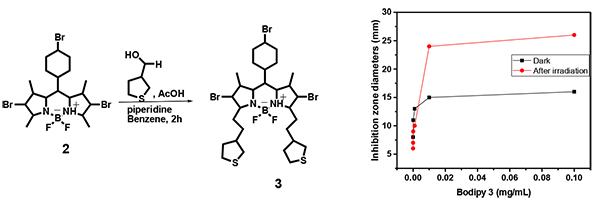Журнал "Макрогетероциклы"
Navigation
News
Impact Factor 2021 = 1.200 has been issued by ISI Web of Knowledge (JCR 2021).
Search
ISSN 1998-9539
Photophysical and in vitro Antibacterial Studies of 2,6-Dibromo-BODIPY Dye Substituted with Dithienylenevinylene at 3,5-Positions
B. T. Bomanda,a W. Waudo,b B. P. Ngoy,a@ J. T. Muya,a P. T. Mpiana,a M. Mbala,a I. Openda,a J. Mack,c and T. Nyokongc
Dedicated to Prof. Ilinga Lopaka on the occasion of his 70th Birthday
aDépartement de Chimie, Université de Kinshasa, B.P. 190 KIN XI, Democratic Republic of the Congo
bJomo Kenyatta University of Agriculture and Technology, Chemistry Department, P.O. Box 62000 Nairobi, Kenya
cDepartment of Chemistry, Rhodes University, 6140 Grahamstown, South Africa
@Corresponding author E-mail: bokolombe@gmail.com
DOI: 10.6060/mhc180898n
Macroheterocycles 2018 11(4) 429-437
Photophysical properties of synthesized 2,6-brominated BODIPY dyes having dithienylenevinylene at 3,5-positions have been investigated in different solvents combining experiment and time dependent density functional theory (TD-CAM-B3LYP). This study shows a good agreement between the measured and computed excitation energies with a small deviation of 25-40 nm. The UV-Visible range corresponding to the electronic transition involving HOMO, HOMO-1 and LUMO orbitals is also reported. Further, the assessment of the antimicrobial activity of the 2,6-brominated BODIPY and 2,6-brominated BODIPY substituted with distyryl at 3,5-postions has shown that at lower concentrations (3.12∙10-3 mg/mL) these synthesized compounds are able to eradicate E. coli and S. aureus upon 25 minutes irradiation using LEDs shining light at 530 nm and 650 nm.

| Attachment | Size |
|---|---|
| mhc180898n.pdf | 1.67 MB |
- 1442 reads
- Русский
